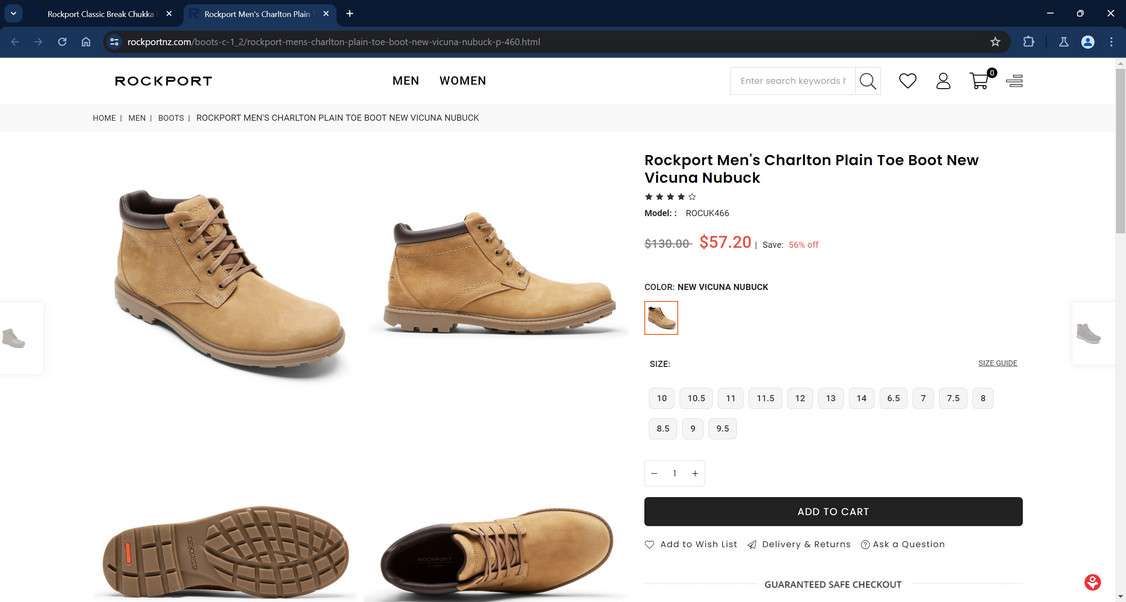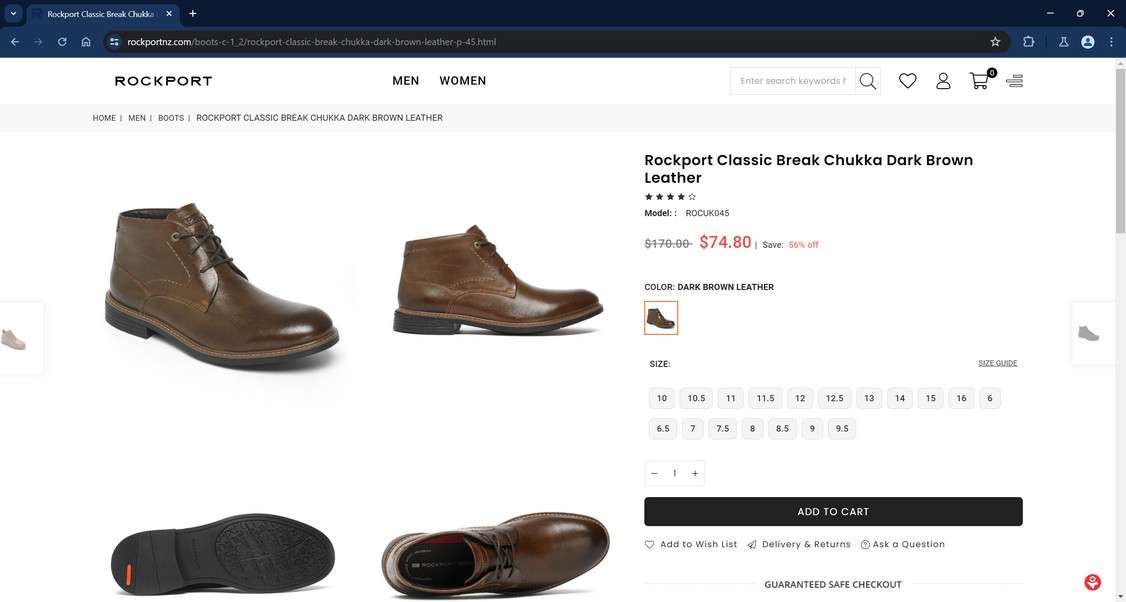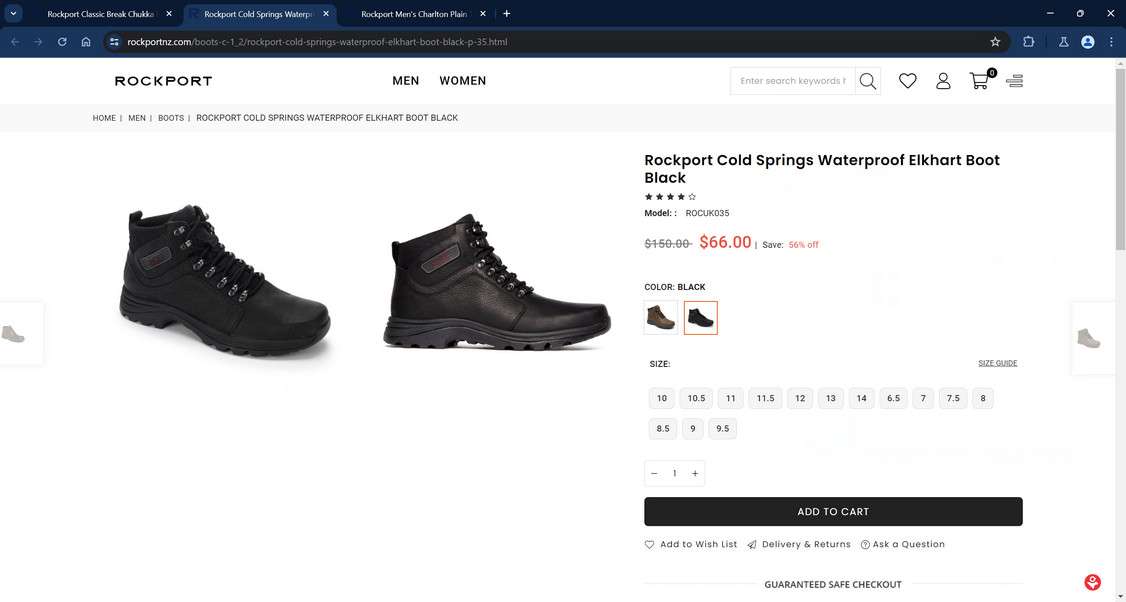Rockport shoes are a well-known and trusted brand for comfortable and stylish footwear. However, scammers have been heavily promoting fake Rockport websites and deals on social media, luring in victims with “clearance sales” advertising up to 90% off.
This article will provide an in-depth overview of how the Rockport scam works, advice for consumers who may have fallen victim, and the key signs to watch out for to avoid getting duped. With online shopping more popular than ever, it’s important to stay vigilant against schemes aimed at stealing money and personal information.



This Article Contains:
Overview of the Rockport 90% Off Sale Scam
The Rockport sale scam is a clever social media scheme that tricks consumers into buying cheap counterfeit shoes. Scammers are heavily promoting fake Rockport websites and deals on Facebook, Instagram and TikTok using paid ads and bots. These sophisticated tactics allow them to target large audiences with convincing clearance sale offers. Victims only discover the fraud after their orders fail to arrive or they receive low-quality knockoffs.
This fraudulent business model can seem convincing at first glance. The scam sites copy Rockport’s official branding and images, giving the appearance of an authorized retailer. They lure in customers with slogans like “Warehouse Clearance Sale – Up to 90% Off!” and exciting countdown timers. Prices start at unbelievable lows like $29 or $39 per pair.
Upon closer inspection though, subtle signs indicate these sites are complete scams designed to steal money and trick consumers. The contact information is fake, policies misleading, and website layout appears cheaply made. Rockport shoes would never be priced so low. Still, these tactics are incredibly effective at driving impulse purchases.
By the time victims realize their orders will never ship, it’s too late to get their money back. The elaborate scheme ensures customers have no recourse with bogus customer service channels. At most, an unresponsive email address may be available. This leaves users frustrated and out of pocket.
Some common excuses the scammers use include “limited quantities” and “flash sales ending soon” to pressure buyers. Fake customer reviews and testimonials help establish trust fast. To unsuspecting shoppers, the clearance event looks 100% authentic.
In 2022 alone, the FTC received over 200 complaints regarding the fake Rockport sales. But many more scam victims likely exist. The scam websites switch domain names frequently to avoid detection, popping up again under new URLs. Social media platforms also struggle to permanently suspend their paid ads.
Several iterations of this scam have been documented, including:
- rockportoutlet.com
- rockportcloseout.com
- rockportsale.net
- rockport-warehouse.com
And countless more continue cropping up. The scam ads link off to new fraudulent sites constantly to avoid blacklisting.
Some of the common slogans used on these Rockport scam websites include:
- “Rockport Warehouse Clearance Sale!”
- “Store Closing Sale – All Items Up To 90% Off!”
- “Rockport Liquidation Sale Extended!”
- “Going Out of Business – Final Days for Savings!”
The scam markets primarily to shoppers in the United States, Canada, the United Kingdom and Australia. Shoes sell for around $29 to $49 per pair in local currencies.
Instagram, Facebook and TikTok have proven highly effective platforms for the scammers to target potential victims. They utilize sponsored posts, fake accounts and engagement groups to broadcast their ads. The high visibility gives their websites perceived credibility.
By driving such heavy traffic to the clearance sale domains, the scammers can earn significant affiliate commissions and ad revenue even if no direct purchases occur. This provides additional motivation to ramp up their social media advertising efforts.
With the right precautions, consumers can avoid accidentally providing payment information to these fraudulent sites. Carefully inspecting for the red flags outlined above prevents consumers from completing a purchase. Sticking to Rockport’s real website ensures you’ll receive authentic shoes as advertised.
The next section will provide a step-by-step walkthrough of how victims get lured in by the scam from start to finish. Understanding the tactics used makes it easier to recognize the signs of a Rockport imposter site. Forewarned is forearmed against these hoax clearance sales targeting shoppers online.
How the Fake Rockport Sale Scam Works
The Rockport clearance scam ensnares victims through a carefully orchestrated sequence of social media marketing, website design and purchase process tricks. By understanding each step of the deception, consumers can better recognize the signs and avoid getting swindled.
Here is an in-depth, step-by-step overview of how the Rockport scam operates from start to finish:
Step 1: You See the Rockport Ad on Social Media
The scam begins with an enticing social media advertisement for a Rockport warehouse clearance sale. These ads are shown to targeted demographics most likely to engage, using Facebook, Instagram and TikTok’s advertising platforms.
The ad features eye-catching photos of Rockport shoes and claims extreme discounts up to 90% off. Urgency is created with a countdown timer of the “sale ending soon”. This pressures viewers to click fast before the deals expire.
Example Facebook Ad:
“Rockport Warehouse Clearance – Shoes Up to 90% Off! Limited inventory! Sale ends in 18 hours!”
To appear even more convincing, the scammers use sponsored influencer promotions. Real influencers share the ads and special promo codes, unaware it is a scam. Their endorsement adds legitimacy.
Step 2: Clicking the Ad Takes You to the Fake Site
Once clicked, the social media ad redirects to an illegitimate website dressed up exactly like Rockport’s real ecommerce store. The site has Rockport’s logo, branding, product images and navigation menu.
Upon first glance, there are no immediate signs this is a scam operation. The URL may be slightly different or unrelated. For example:
- rockportwarehouseclearance.com
- rockportoutletstore.net
- rockport-liquidation.co
But to victims, the domain appears reputable enough. The scam stores also have SSL certification and security badges for added trust.
Step 3: Browse Through Incredible Discounted Deals
As you browse the clearance sale site, unbelievable prices are shown for Rockport’s best-selling shoes. Items typically $250+ are discounted down to $39 or $49. Slogans boast “Save 90%!” and “All Items Must Go!”.
Fake customer testimonials, reviews and other social proof elements help reassure shoppers the sale is real. Limiting inventory counters also pressure customers to buy before popular sizes sell out.
For example, a $250 pair of Rockport boots on sale for $49.99 with a tagline “Our #1 Best Seller! Only 2 Left!” creates urgency.
Step 4: Complete Checkout Without Any Issues
The online checkout process is fast and smooth. Shoppers can quickly pay with a credit card for their deeply discounted products.
The site does not validate customer data, allowing anyone to enter a fake name, email and address during checkout. This bypasses fraud protections.
An order confirmation is immediately sent to the submitted email address. At this point, the victim assumes their shoes will arrive soon.
Step 5: Never Receive the Rockport Shoes
Weeks pass without any shipping notifications or updates on the order status. Some victims eventually receive cheap, poor quality shoes clearly not from Rockport.
Any requests for cancellation or refunds go completely unanswered. At this point, it dawns on the victim they have been scammed out of their money.
Step 6: No Way to Contact the Scammers
Panicked customers who attempt to email, call or message the company receive zero response. The contact information on the site was completely fake from the start.
Negative reviews warning other shoppers also get censored. The elaborate scheme provided no legitimate method of recourse for unhappy shoppers.
By following these calculated steps, the scammers convince even savvy online shoppers they are dealing with the real Rockport. Victims hand over their money willingly under false pretenses.
The “too good to be true” discounted prices overcome rational judgement. Only later do they realize the website was an elaborate hoax to steal credit card information without any intent of sending the actual shoes.
Following this playbook step-by-step allows the Rockport scammers to operate out in the open while avoiding repercussions. But being aware of their tactics makes it much simpler to recognizes the signs of their scam.
The next section will cover what consumers can do if they unfortunately fell victim to one of these fraudulent schemes. Reporting the scam and monitoring accounts can help limit losses.
Recognizing the Red Flags of the Rockport Scam Websites
While the fake Rockport sites are designed to look authentic, upon closer inspection there are a number of red flags that give them away as fraudulent. Learning these key indicators can help prevent consumers from being deceived in the first place.
Here are the most common signs that a supposed Rockport sale website is an outright scam:
Suspicious & Unverified URLs
The domains used in the scam have unusual or nonsensical naming and clearly do not belong to the official Rockport company. Examples include:
- rockport-clearancesale.com
- rockportstore.net
- shoprockportsale.co
Look out for misspellings, extra words added, or URLs hosted through sketchy registrars. None of the legitimate Rockport sites would use this type of naming.
Unbelievable Discounts Up to 90% Off
One of the first red flags is prices that seem far too good to be true. Authentic Rockport shoes retail for $100 to $250 normally. Discounts over 90% off are simply unrealistic. Rockport’s real sales only offer 25-30% markdowns at most.
Seeing current models of Rockport shoes priced at $29 or $39 is a clear indicator you’re on a scam website. The prices make no logical sense.
Countdown Timers and High Pressure Tactics
The scam sites often use countdown timers and language creating false urgency like “Sale Ending Soon!” This tricks shoppers into impulse purchases without deeper inspection of the site’s legitimacy.
Any limited-time offers or implications of expiring inventory should be seen as psychological tricks, not actual scarcity. Avoid being rushed into buying.
Lack of Verifiable Contact Information
Checking for valid contact information can reveal the truth. The scam sites either provide no phone number, email or physical address, or fake details that lead nowhere.
You should be able to call a listed customer service line or locate the company address through an online search. Dead ends indicate you’re dealing with scammers.
No Social Media Presence
Authentic brands maintain active social media accounts like Facebook, Instagram and Twitter that showcase products and interact with customers.
However, searching the social channels of a Rockport scam site will uncover no posts and zero followers. Undeveloped profiles expose the “company” as an imposter.
By watching out for these common red flags, savvy shoppers can avoid being tricked into purchasing from the growing number of Rockport scam websites. Only buy directly from a brand’s real website or verified stores like Zappos and Nordstrom. If you see multiple signs of a shady operation, trust your instincts and steer clear.
Identifying the Rockport Scam on Social Media
The scammers advertising fake Rockport sales leverage multiple platforms to reach victims, primarily Facebook, Instagram and TikTok. By understanding the tactics used on each network, consumers can better protect themselves.
Spotting the Scam on Facebook
On Facebook, the scam ads promoting Rockport clearance sales often:
- Use exciting headlines boasting 90% off deals, warehouse sales or going out of business
- Have images of Rockport shoes stolen from the official website
- Drive clicks to sketchy domains not affiliated with Rockport
- Use high pressure tactics like “Today Only!” and urgent countdown timers
- Have minimal comments, shares or interactions from real profiles
For example:
An ad with a headline “Rockport Warehouse Sale! Up to 90% off – Today Only!” featuring a nice pair of Rockports. But clicking the link goes to rockportsale-store[dot]com. And the page has a timer saying “3 hours left!”. This would signal a fraudulent Facebook ad.
Identifying the Scam on Instagram
On Instagram, some signs of the Rockport scam ads include:
- Being promoted by influencers as “sponsored” content, adding false credibility
- Using edited images or AI-generated video of Rockport shoes
- Directing clicks to odd domains like @rockportlimited or @officialrockportstore
- Too-good-to-be-true discounts in the captions like “Get 90% off!”
- Using Instagram Stories for flash sales and other pressure tactics
For example:
A influencer posts a sponsored ad about a “Rockport Blowout Sale!” with CGI Rockport shoes. Their caption says “Use my code for 90% off!” and links to @rockportsaleshop. The profile looks fake and has no other posts. Clearly a scam attempting to leverage that influencer’s audience.
Recognizing the Scam on TikTok
On TikTok, the scam is promoted via:
- Fake TikTok accounts reposting the same clearance sale ads
- Video edits showing the Rockport website and huge discounts
- Links in bios and captions leading to sketchy Rockport store sites
- Duped influencers sharing excitement for clearance events and promo codes
- Comment bots flooding videos with positive reactions
For example:
A TikTok video shows screenshots of the Rockport website with shoes priced at $49. The caption claims it’s a massive warehouse clearance sale ending today. But the link goes to rockportliquidation[dot]co, indicating a scam site.
By understanding the scam tactics on each platform, consumers can better identify fraudulent Rockport promotions on social media. If an offer seems unrealistic, approach with extreme caution, verify the source, and avoid providing personal information or payment.
What to Do if You Fell Victim to the Rockport Scam
If you unfortunately placed an order on one of these fake Rockport clearance websites, here are some steps to take right away:
- Contact your bank or credit card company. Report the incident and request to chargeback the fraudulent transactions. Provide them details on the scam and that you never received the items ordered.
- Report the website to the FTC. File a complaint with the Federal Trade Commission so they can open an investigation against the scammers.
- Warn others about the scam. Leave comments about your experience on scam warning sites so other consumers don’t get tricked. Spread awareness on social media.
- Look out for identity theft. Scammers may have accessed personal data like your name, address, or credit card info. Sign up for credit monitoring and keep an eye out for any suspicious activity.
- Adjust privacy settings. Reduce public access to your social media profiles so scam ads have less data to target you. Don’t accept friend requests from strangers.
- Contact Rockport customer service. Legitimate Rockport reps may be able to offer guidance or escalate the issue if the brand’s name is being illegally used.
Stay persistent reaching out to relevant authorities and monitors your accounts closely in the coming months. With fast action, you can limit any losses from the scam.
The Bottom Line
The scam of fake Rockport clearance sales being promoted on social media serves as a cautionary tale for online shoppers. If an offer looks too good to be true, approach with extreme skepticism. Verify the retailer through independent research before providing payment or personal information.
Whenever you see unbelievable discounts from a previously unknown company, resist that impulse buy. Don’t let fear of missing out overcome rational judgement. Check for the signs outlined above to determine if a sale is legit or a scam.
Stay vigilant and warn your friends and family to do the same. By following smart shopping practices, consumers can avoid losing money and frustrations to these predatory scammers impersonating well-known brands like Rockport. Only you can protect yourself from online retail fraud.










